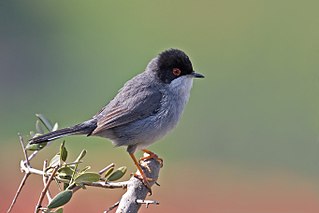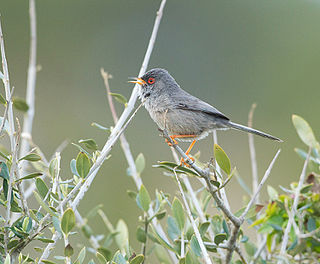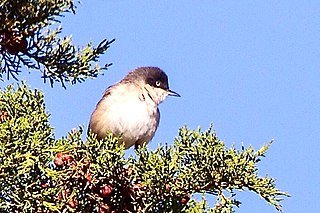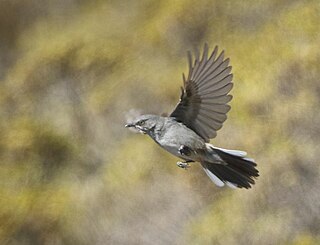
The barred warbler is a typical warbler which breeds across temperate regions of central and eastern Europe and western and central Asia. This passerine bird is strongly migratory, and winters in tropical eastern Africa.

The common whitethroat or greater whitethroat is a common and widespread typical warbler which breeds throughout Europe and across much of temperate western Asia. This small passerine bird is strongly migratory, and winters in tropical Africa, Arabia, and Pakistan.

The Sardinian warbler is a common and widespread typical warbler from the Mediterranean region. Like most Curruca species, it has distinct male and female plumages. The adult male has a grey back, whitish underparts, black head, white throat and red eyes. Plumages are somewhat variable even in the same locality, with the intensity of a reddish hue on upper- and/or underside that varies from absent to pronounced. The female is mainly brown above and buff below, with a grey head. The Sardinian warbler's song is fast and rattling, and is very characteristic of the Mediterranean areas where this bird breeds.

The lesser whitethroat is a common and widespread typical warbler which breeds in temperate Europe, except the southwest, and in the western and central Palearctic. This small passerine bird is strongly migratory, wintering in Africa just south of the Sahara, Arabia and India.

The Dartford warbler is a typical warbler from the warmer parts of western Europe and northwestern Africa. It is a small warbler with a long thin tail and a thin pointed bill. The adult male has grey-brown upperparts and is dull reddish-brown below except for the centre of the belly which has a dirty white patch. It has light speckles on the throat and a red eye-ring. The sexes are similar but the adult female is usually less grey above and paler below.

Balearic warbler is a typical warbler, genus Curruca. It is endemic to the Balearic Islands, apart from Menorca. It groups with the Marmora's warbler, Tristram's warbler and the Dartford warbler.

Rüppell's warbler is a typical warbler of the genus Curruca. It breeds in Greece, Turkey and neighbouring islands. It is migratory, wintering in northeast Africa. This is a rare vagrant to western Europe. The name is occasionally cited as "Rueppell's warbler".

The western Orphean warbler is a typical warbler of the genus Curruca. This species occurs in summer around the Mediterranean, through western Europe and extending into northwest Africa. It is migratory, wintering in Sub-Saharan Africa. It is a rare vagrant to northern and north-western Europe.

Marmora's warbler is a typical warbler in the Sylviidae family. The specific sarda is a Latin feminine form for a person from Sardinia.

The spectacled warbler is a species in the typical warbler genus, Curruca. The specific conspicillata is from Latin conspicillum, a place to look from, equivalent to "spectacled".

The chestnut-vented warbler, chestnut-vented tit-babbler or rufous-vented warbler is an Old World warbler.

Layard's warbler or Layard's tit-babbler, is a species of Old World warbler in the family Sylviidae. It is found in Lesotho, Namibia, and South Africa. Its natural habitat is subtropical or tropical dry shrubland.

Curruca is a genus of Sylviid warblers, best represented in Europe, Africa, and Asia. All of these species were formerly placed in the genus Sylvia.














